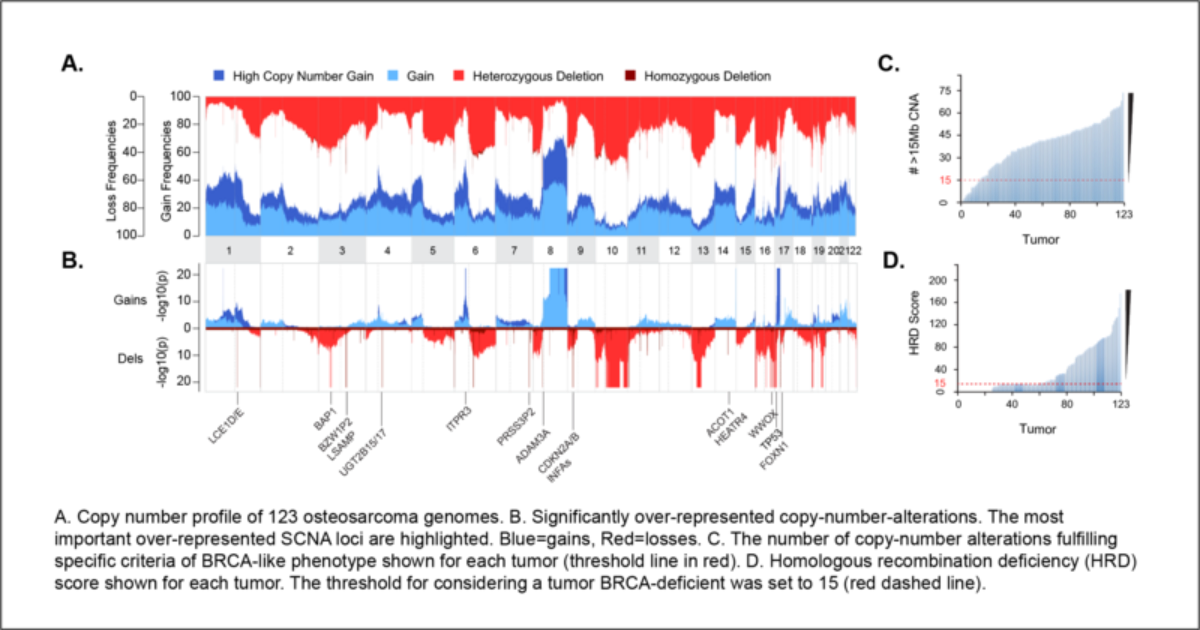Bone Tumors
Principal Investigators

Group Members
Our Science
The research group of the Bone Tumour Reference Center is strongly supported by endowments of the Gertrude von Meissner Foundation and the Swiss National Science Foundation (SNF). Prof. Daniel Baumhoer, Dr. Michal Kovac and Dr. Baptiste Ameline focus their work on the molecular pathogenesis of bone tumours, particulary on bone-forming tumours including osteosarcoma, the most common primary malignant tumour of bone.
The clonal evolution of osteosarcoma
Osteosarcoma primarily affects children and adolescents during skeletal maturation and most commonly involves the metaphyses of long bones. Due to early systemic spread, the prognosis of patients is dismal without (neo-)adjuvant chemotherapy and radical surgery. In 60-70% of patients long-term survival can be achieved leaving 30-40% of patients without effective treatment options. The genome of osteosarcoma is characterized by a high amount of inter- and intratumoral heterogeneity caused by different mechanisms of chromoanagenesis in the majority of cases. At the end of 2015, we were able to show for the first time that >80% of conventional osteosarcomas harbor mutations in genes that, together with the BRCA1/2 genes, are involved in forming the functional BRCA complex and play a central role in DNA double-strand repair. In fact, the sequencing data showed mutation signatures and copy number patterns nearly identical with BRCA1/2-mutated breast and ovarian carcinomas, a phenomenon referred to as "BRCAness" in the literature. Osteosarcoma cell lines with the same genomic patterns, showed marked depletion and reduction in growth after be-ing treated with a so-called PARP inhibitor, which selectively exploits this DNA repair weak-ness.
In our current studies, we follow the genetic changes including BRCAness from the first (diagnostic) biopsy over the course of the disease, first on resection specimens after neoadjuvant chemotherapy and later on metastases. Our results assume that in the majority of cases BRCAness will persist throughout the course of the disease and is not limited to clones that have already perished during neoadjuvant therapy. Another very interesting aspect is that metastases and primary tumors often differ significantly from each other in terms of number and type of mutations. The only reasonable explanation for this seems to be that the respective clones separate already early after the onset of the disease and also systemic spread is initiated much earlier than anticipated.

Other projects
We are currently also pursuing other projects on osteosarcoma that try to shed light on the role of NTRK rearrangements and the IGF1R signal cascade in this highly aggressive disease of bone. Other studies focus on methylation and copy number profiles of metastasizing chondroblastoma and osteoblastoma.
Selected Publications
- Kollar A., Rothermundt C., Klenke F. et al. Incidence, mortality, and survival trends of soft tissue and bone sarcoma in Switzerland between 1996 and 2015. Cancer Epidemiol. 2019 63, 101596.
- Heikinheimo K., Huhtala J. M., Thiel A. et al. The Mutational Profile of Unicystic Ameloblastoma. J Dent Res. 2019 98, 54-60.
- Baumhoer D., Kovac M., Sperveslage J. et al. Activating mutations in the MAP-kinase pathway define non-ossifying fibroma of bone. J Pathol. 2019 248, 116-122.
- Baumhoer D., Amary F., Flanagan A. M. An update of molecular pathology of bone tumors. Lessons learned from investigating samples by next generation sequencing. Genes Chromosomes Cancer. 2019 58, 88-99.
- Amary F., Perez-Casanova L., Ye H. et al. Synovial chondromatosis and soft tissue chondroma: extraosseous cartilaginous tumor defined by FN1 gene rearrangement. Mod Pathol. 2019 32, 1762-1771.
- Amary F., Markert E., Berisha F. et al. FOS Expression in Osteoid Osteoma and Osteoblastoma: A Valuable Ancillary Diagnostic Tool. Am J Surg Pathol. 2019 43, 1661-1667.
- Baumhoer D. Pathogenesis and genetics of osteosarcoma: Current concepts and developments. Pathologe. 2018 39, 139-145.
- Behjati S., Tarpey P. S., Haase K. et al. Recurrent mutation of IGF signaling genes and distinct patterns of genomic rearrangement in osteosarcoma. Nat Commun. 2017 8, 15936.
- Baumhoer D. Bone-Related Lesions of the Jaws. Surg Pathol Clin. 2017 10, 693-704.
- Amary F., Berisha F., Ye H. et al. H3F3A (Histone 3.3) G34W Immunohistochemistry: A Reliable Marker Defining Benign and Malignant Giant Cell Tumor of Bone. Am J Surg Pathol. 2017 41, 1059-1068.
- Baumhoer D. The clonal evolution of osteosarcomas. Pathologe. 2016 37, 163-168.
- Amary M. F., Berisha F., Mozela R. et al. The H3F3 K36M mutant antibody is a sensitive and specific marker for the diagnosis of chondroblastoma. Histopathology. 2016 69, 121-127.
- Salinas-Souza C., De Andrea C., Bihl M. et al. GNAS mutations are not detected in parosteal and low-grade central osteosarcomas. Mod Pathol. 2015 28, 1336-1342.
- Kovac M., Blattmann C., Ribi S. et al. Exome sequencing of osteosarcoma reveals mutation signatures reminiscent of BRCA deficiency. Nat Commun. 2015 6, 8940.
Awards and Grants
Awards
- Virchow Prize of the German Society of Pathology (2016)
- President's Medal of the International Skeletal Society (2019
Funding
- Swiss National Science Foundation
- Gertrude von Meissner Foundation
- Foundation of the Bone Tumor Reference Center
